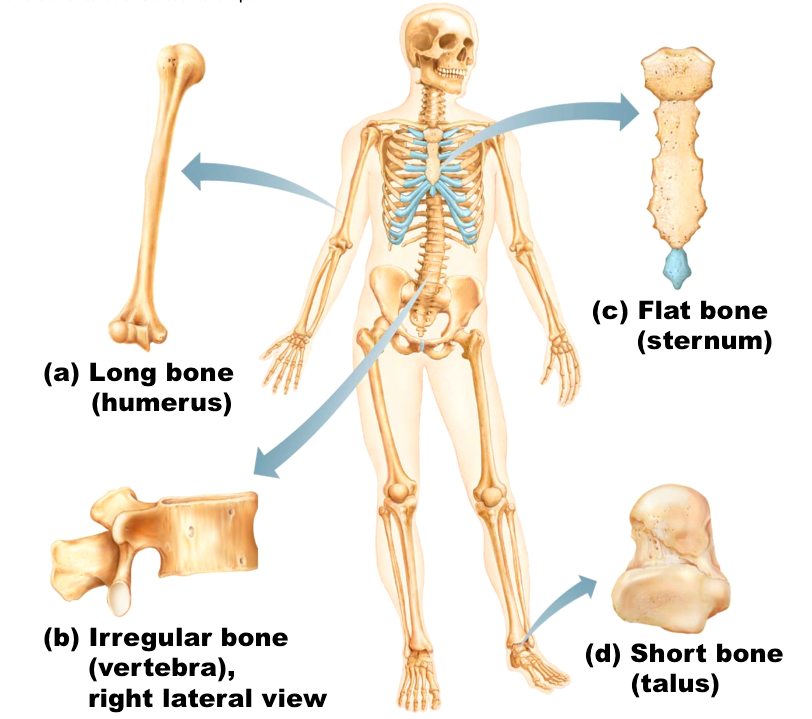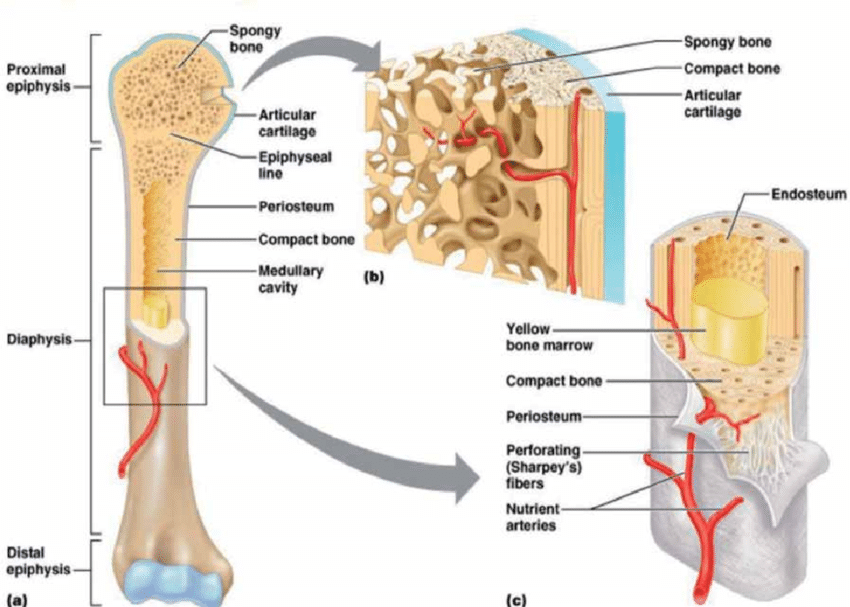Bones and Cartilages of the Human Body
1/63
Earn XP
Description and Tags
This set of flashcards covers key concepts related to the bones and cartilages of the human body, including their structure, function, types, growth, and conditions associated with them.
Name | Mastery | Learn | Test | Matching | Spaced |
|---|
No study sessions yet.
64 Terms
What are the two components of the fetal skeleton before week 8 of development?
Hyaline cartilage wrapped in fibrous membranes.
What is the primary tissue that cartilage is replaced by after week 8 of development?
Bone.
Where does cartilage remain in the adult human body?
Only in areas where flexible tissue is needed, such as joints.
What is a key characteristic of skeletal cartilage? And what does that cause?
It contains no blood vessels or nerves. It takes longer to heal.
What gives skeletal cartilage its resiliency and what does that allow?
A high percentage of water, which allows the cartilage to compress and return to its original shape. (compressive shock)
What surrounds skeletal cartilage and resists outward expansion?
The perichondrium. (Dense irregular connective tissue)
Name the three types of skeletal cartilage. Which is the most abundant?
Hyaline, elastic, and fibrocartilage. Hyaline cartilage is the most abundant.
What is the main function of hyaline cartilage?
Support and flexibility.
What type of cartilage is found in the external ear? What does this cartilage allow for?
Elastic cartilage.This cartilage can take repeated bending.
Where are the places fibrocartilage is found?
In intervertebral discs, pubic symphysis, and the menisci of the knee.
What are the two types of growth in cartilage development?
Appositional and interstitial growth.
What type of cartilage growth occurs from the outside edge? How does that growth occur? What type of growth occurs from inside to the outside? How does that one occur?
Appositional growth- cells under perichondrium secrete matrix from outside edge
Interstitial growth- lacunae bound chondrocytes expand cartilage from within.
What occurs when cartilage becomes calcified? What is calcification?
It happens during normal bone growth and old age. Calcification is when calcium builds in tissue, causing it to harden adn become bone.
What are the two major classifications of bones?
Axial skeleton and appendicular skeleton.
Name a function of bones related to the body structure.
Support- bones provide a framework that supports the body and cradles organs.
What is the protective function of bones?
They provide a protective casing for the brain, spinal cord, and vital organs. (ribs, vertebrae)
How do bones function in relation to muscles?
They act as anchors (anchorage) , serving as levers for muscle-to-bone (tendons)
What do bones serve as a reservoir for?
Store minerals (mineral storage), especially calcium and phosphorus.
Where does hematopoiesis occur in the bones? What exactly is it?
Within the marrow cavities. It is the process of red blood cell formation.
What type of marrow is responsible for fat storage?
Yellow marrow.
What is is the function of osteocalcin as far as it’s role within bone.
Osteocalcin produces hormone, regulating insuline release and glucose homeostasis
What are the three levels of bone structure?
Gross, microscopic, and chemical.
(Gross Anatomy of Bone)
What are the two textures of bone? Describe them?
Compact bone- dense outer layer and spongy bone- honeycomb of trabeculae filled with red or yellow bone marrow
What is the diaphysis of a long bone?
The tubular shaft of long bones.
What type of cartilage covers the joint surface of the epiphysis?
Articular (hyaline) cartilage.
What supplies the outer membrane of bones known as the periosteum?
Nerve fibers, blood, and lymphatic vessels.
What is the function of the endosteum in a bone?
It lines the internal surfaces of bone.
What type of bone has no diaphysis or epiphyses?
Flat bone.
Where is red marrow located in adults?
In the spongy region of flat bones 9skull, sternum) , some irregular bones (vertebrae), and the heads of femur and humerus (proximal epiphysis)
What are the two main component of the organic portion of bone? What are their percentages as far as the chemical composition of bone they make up? Living and non-living
Cells- living make up less than 1% & osteoid-nonliving makes up 35%.
What are the main component of the inorganic portion of bone that contributes to its hardness?
Mineral salts (65%), primarily calcium phosphates, responsible for bone hardness and resistance to compression
What processes occurs to form bone before birth? Describe them. What bones do they affect
Intramembranous and endochondral ossification.
Intramembraneous- outside to inside growth from messechyme. Forms flat ones of skull and clavicle
Endochondral- outside to inside using osteoblasts that replace cartilage with bone. Forms majority of bones.
What is closure of the epiphyseal plates associated with?
The end of growth in length of long bones.
What is the term for the process that involves both deposit and resorption of bone tissue?
Bone remodeling.
What regulates blood calcium levels?
Calcitonin and parathyroid hormone (PTH).
What type of fracture involves broken bone portions pressed inward?
Depressed fracture.
What is a common type of fracture in children?
Greenstick fracture.
What is the process of manipulating broken ends of a bone back into place without surgery called?
Closed reduction.
What is the initial blood clot at the fracture site known as?
Hematoma.
What occurs a few days after a fracture at the site?
Fibrocartilaginous callus formation.
What imbalance condition is characterized by bone reabsorption outpacing bone deposit?
Osteoporosis.
What is osteomalacia?
Condition where bones are inadequately mineralized, leading to softened bones.
What condition in children is characterized by inadequately mineralized bones leading to deformities?
Rickets.
What is Paget's disease characterized by?
Excessive bone formation and breakdown.
What is the most common malignancy of bone primarily found in children and young adults?
Osteosarcoma.
What syndrome is characterized by progressive bone loss in common areas such as the ribs and spine?
Gorham-Stout Syndrome (Vanishing Bone Disease).
What does the axial skeleton consist of? What does the appendicular skeleton consist of?
Axial skeleton consists of head, neck and trunk> Appendicular skeleton consists of arms and legs (where shoulder girdles and hips are)
What makes bone an organ? List them
Bone is an organ because it contains various tissues such as bone, cartilage, nerve, fibrous connective, epithelial and smooth muscle.
What are the markings of bone? What do they serve?
Markings of bone are bulges, depressions, and holes. They serve various functions, including muscle, ligament and tendons attachment, joint formation, and passageways for blood vessels and nerves.
What are the four classifications of bone (by shape)? Describe them?
The four classifications of bone by shape are long, short, flat, and irregular bones.
Long bones- longer than wide. (humerus
Short bones- equal width and length (talus)
Flat bones- flat (sternum)
Irregular bones- complex shape (vertebrae, hips)

What are the components of the diaphysis and how are they layered?
The compact bone surrounds the medullary cavity
The medullary cavity surrounds the yellow bone marrow (fat)

How is the periosteum secured to the bone?
It is secured to the bone by perforating (sharpey) fibers (strongest at tendon, ligament attachment)
What is the periosteum and what is it outer fibrous layer made of (tissue)?
The periosteum is the outer membrane. It’s outer fibrous layer is made of dense irregular connective tissue.
What cells do the inner osteogenic layer of the periosteum consist of?
Osteoblasts & osteoclasts are present in the inner osteogenic layer.
What do flat ones contain?
They contain bone marrow between the trabeculae.
What are the two parts of the epiphysis?
Proximal and distal epiphysis of long bones.
Where is red marrow located in infants?
In the medullary cavities and all areas of spongy bone
What are the cells of the organic portion of bone?
Osteoblasts, osteocytes, osteoclasts, and osteogenic. (label)
In regards to how bone develops, what is happening before birth (before week) Until early adulthood? As adults?
Before birth- bony skeleton forming
Until early adulthood- Bone growth (elongation- length and thickening)
As adults- remodeling and repair
How do long bones grow in length after birth? What do they increase?
They grow at the epiphyseal plate—basically, the growth plate at the ends of bones. Bone grows toward the shaft (diaphysis). They increase the diaphysis length (labeled image)
When do bones usually stop growing in length? What do the growth plates get replaced by?
Around age 18 for girls and 21 for boys. After that, the growth plates (cartilage) get replaced by bone.
What’s the name of the growth that makes bones thicker? Describe it. How does it grow.
Appositional growth. It grows from the outside inward from cells lining the periosteum. (labeled image)
What helps control how bones grow?
Hormones. Growth hormone and thyroid hormone play a role, and sex hormones (like estrogen and testosterone) kick in during puberty.
What is boen deposit and